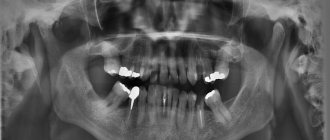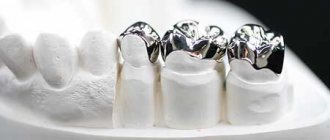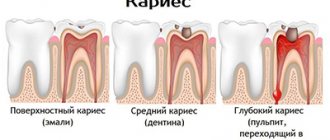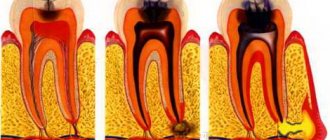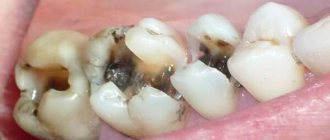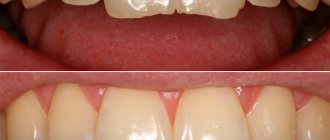Many patients do not know that they can put fillings on their front teeth. Its goal is not only to eliminate defects, but also to restore anatomical, physiological and aesthetic properties.
The procedure is quite popular. In order for the result to please the patient, it is necessary to choose a competent specialist with extensive experience. A professional will select the necessary material individually for each type of teeth and install the product so that it will not be noticeable in the smile area.
Installing a temporary filling
A filling between the front teeth is often placed due to carious lesions. For several days, it protects healthy tissues and nerve endings from external influences.
After a session of cleaning the canals and removing the nerve, the structure is replaced with a permanent one.
Life time
temporary product depends on the need for installation. As a rule, it is worn for no more than one month. Lasts about three days if arsenic is present.
When treating pulpitis or advanced stages of caries, the reaction of the unit is checked. Antibiotics are applied under the material. In this case, you need to walk for at least three weeks. The installation method is identical.
The following can be used as the main material:
- polycarboxylate cement,
- dentine,
- vinoxol,
- karyosan,
- softened paste
Cost of services
Consultation with an implant surgeon 0 rub.
1-canal tooth (canal filling with gutta-percha pins) 750 rub.
2-canal tooth (canal filling with gutta-percha pins) 980 rub.
3-canal tooth (canal filling with gutta-percha pins) RUB 1,300.
Placing a temporary filling costs 200 rubles.
Compomer filling for permanent teeth RUB 1,000.
Filling for permanent teeth made of gypsum resin, cotton RUB 1,200.
Filling for permanent teeth made of photocomposite RUB 1,800.
Placement of a light-curing filling for non-carious lesions RUB 2,000.
Placement of a light-curing filling for average caries RUB 2,500.
Placement of a light-curing filling for deep caries RUB 3,000.
Placement of a light polymerization filling for periodontitis (taking into account the formation of a cavity and the application of a lining) RUB 2,350.
Placement of a light polymerization filling for pulpitis (taking into account the formation of a cavity and the application of a gasket) RUB 2,370.
Restoration of the crown part of a tooth using light polymerization materials (caries) RUB 3,050.
Restoration (caries, pulpitis) RUB 4,650.
Replacing a filling
Sometimes it becomes necessary to change fillings on the front teeth. Replacement is due if it is fixed:
- Violation of the integrity of the closure of the carious cavity. This process provokes infection.
- Vertical or horizontal shrinkage of material.
- Heavy load due to chewing. Because of this, destruction occurs.
- The development of periodontal tissue diseases - gingivitis, periodontitis.
- Overhang of the edges on the gum.
- Wear due to flat occlusal surface.
- Change in the shade of an artificial tooth (usually darkening).
- Poor quality of oral hygiene.
- Diastema of the frontal units.
- Changing the inclination.
- Insufficient cleaning of dental plaque in the area adjacent to adjacent molars.
Our specialists
The specialists of our clinic are dental therapists, surgeons and periodontists, implantologists with extensive practical experience. They use evidence-based medicine and implement the latest developments in dental treatment.
The task of the clinic’s doctors is to preserve the tooth and make the treatment understandable, comfortable and painless. Putting a filling on a tooth means preserving the health of the oral cavity and the whole body. See our price list for the average cost of treatment. The final price is determined only after examination and diagnosis.
Painfulness of the procedure
Most people are afraid of the procedure precisely because of toothache, but modern technology and the use of anesthesia eliminate this ailment.
The session is completely painless. To reduce the likelihood of discomfort, all manipulations are carried out after the administration of an anesthetic. If there is no nerve, the procedure is performed without anesthesia. The patient may feel slight pressure on the gum.
An exception is intolerance to certain medications used for anesthesia. The choice is made in favor of a similar drug with a different active substance.
After the injection, no painful sensations are observed.
It hurts if there is a strong inflammatory process at the root apex and in the canals. Unpleasant sensations occur only when the drug gets into the periodontal tissues. They go away instantly after increasing the dosage of the painkiller.
Some pain is possible if there is a deep stage of carious lesions, depulpation or canal treatment is performed, or sensitivity is increased.
Installation on the front teeth
The procedure takes from half an hour to an hour and a half, depending on the complexity of the problem.
The stages of setting up the frontal units are as follows:
- Carrying out professional oral hygiene. The hygienist cleans the molars and interdental space from plaque.
- Determination of tone.
- Introduction of anesthesia. The anesthetic is selected taking into account the patient's tolerance to the active substance. The injection is given in the gum area.
- Removal of caries. If the pathology affects only the superficial layers, then the disease is eliminated by grinding.
- Removal of the inflamed area of the pulp.
- Preparing the plane. The dentist treats the surface with a drill.
- Acid and adhesive treatment of dentin and enamel for better adhesion.
- Treatment with an antiseptic solution. This point is important in order to reduce the risk of microbial development.
- Application of material. It hardens quickly, so it is important to “shrink” it immediately with a special tool.
- Bite check. To do this, the doctor asks the patient to bite down on a plate of dye. When a certain area of this element is painted, a violation is considered.
Performing grinding and polishing of the artificial surface for proper bite and ideal smoothness.
When restoring the anterior dentition, diastema closure is often performed. This is possible if the spaces between the central molars are small. More material is applied to the incisors to increase their width. Thus, the distance between them disappears.
Types of fillings for front teeth
The design on the frontal incisors must have such properties as resistance to abrasion and destruction, biocompatibility, thermal conductivity to protect against exposure to different temperatures, and matching the enamel in structure and shade.
There are several types of materials. They have their own characteristics:
- Cement silicophosphate
(zinc phosphate or polycarboxylate) material. Among the advantages, it is worth highlighting the low cost. However, there are many more disadvantages: Firstly, fixation and adherence to the walls is insufficient. Secondly, the color is noticeably different, since the cement quickly acquires a yellowish tint. Thirdly, the surface of the artificially created unit is poorly polished. - Composite
The structure, shape and color of a natural incisor are most clearly conveyed. It is characterized by increased strength. The downside is the risk of roughness if the material is not mixed well. - Plastic.
Its advantages include a tight fit, aesthetic component and mechanical strength of the material. The color palette is wide and you can easily choose a shade to match the color of your teeth. The negative aspects are that the plastic darkens and turns yellow, the surface gradually becomes rough, acrylic releases toxins and also shrinks.
When choosing, you need to know how long different types of fillings last. Cement is short-lived. Their service life does not exceed one and a half years. Plastic products last up to three years. Good composite fillings last up to five years.
Types of filling materials
| Material type | Varieties | Description |
| Cement | – Zinc phosphate – Silicate – Glass ionomer | Currently, of all types of cement fillings, only glass ionomer fillings are actively used, since they provide good mechanical and chemical bonding with tooth tissues. Zinc-phosphate fillings tend to shrink, so they are almost never used when filling teeth for caries. Silicate materials are considered toxic and also have restrictions in their use. |
| Metal | – Gold – Copper – Silver | They are distinguished by high quality and a very large margin of safety. On the other hand, amalgam fillings shrink over time and are not always airtight, which can lead to the development of secondary caries. Due to low aesthetic indicators, they are used for filling chewing teeth. |
| Composite materials | – Acrylic – Epoxy – Light-curing – Chemical-curing | Composite fillings are obtained by mixing organic and inorganic elements. Due to the noticeable disadvantages of filling teeth with composite materials (rapid wear and toxicity for acrylic ones, fragility for epoxy ones), the first two types of fillings are practically not used. Light-curing composites are considered the best: they quickly harden under the influence of ultraviolet radiation and can be used in any part of the jaw. The procedure is often called light dental filling. |
| Compomer | It is a kind of hybrid of glass ionomer and composite | Very aesthetic and high-quality fillings, which are most often used in the frontal region when restoring teeth after chips. Their only drawback is fragility. |
| Materials for temporary fillings | – Artificial dentin – Soft dentin paste – Cariosan (cement) – Vinoxol (zinc oxide based) | They are often placed during pulpitis to check the reaction of the tooth, as well as after filling root canals until a permanent filling is installed. Temporary fillings are also used when filling a tooth under a crown. |
The best choice of fillings for front teeth
The filling must close the cavity and prevent infection of the canals. In the case of front teeth, the aesthetic aspect comes to the fore, so the material must have the appropriate properties.
The most durable fillings for damaged front teeth are light products
. They are made from a material that hardens under ultraviolet rays. The composition contains heliocomposite, glass-ceramic filler, and resin.
Durability of photopolymers
Photopolymers are characterized by increased strength. They can last up to 10 years. They are resistant to temperature, restore length and shape.
Reflective filling has many advantages
:
- Eating food and water is allowed immediately.
- Increased adhesive ability.
- Plastic. The material allows you to clean out any pores and cracks.
- Layer-by-layer application. Due to this, the grip is enhanced.
- The percentage of shrinkage is minimal compared to chemical analogues.
- Does not release toxins.
- Possibility of fixing in a small area.
- Possibility of choosing a color that is similar to enamel.
Minus
is high cost. As a result of the use of a UV lamp, the price does not allow the use of a light filling as a temporary structure.
Let's sum it up
There are many types of dental fillings for filling teeth, which differ in materials of manufacture, purpose and other criteria. The type of product is selected together with the attending physician. In this case, it is important to take into account the quality of adhesion to natural surfaces, aesthetic properties, hardening speed and other points. For many patients, the cost of installation is a deciding factor, so strength and durability take a back seat.
The price depends on many factors, for this reason it is important to carefully consider the choice of treatment method. Having figured out what types of permanent dental fillings there are (the names of the types are discussed above), you can forget about pain and other discomfort for a long time, enjoying a dazzling smile.
Yellowing of fillings on front teeth
Patients often experience discoloration of artificial units.
Causes
Common causes of pathology are:
- Getting injured.
- Secondary caries.
- Drinking black tea or coffee.
- Smoking.
Darkening is possible when the nerve is removed.
Correction methods
The first step is to carry out the whitening procedure. You can get rid of yellowing only with photopolymers. Only if the structure has lightened slightly does it need to be replaced.
Whitening methods
Photopolymers are bleached using the in-channel method. A special gel is injected into the root canal and a temporary structure is placed. After 2-3 procedures, the shade becomes lighter, and the structure is replaced with a permanent one.
Anesthesia and sedation in dentistry
Pain in the teeth and trigeminal nerve system is a dangerous condition for the patient. In severe cases, shock may develop. Therefore, in the overwhelming majority of cases, during filling, anesthesia is performed, and in case of complex diagnoses, drug sedation is used. General anesthesia is not used, as it requires the administration of specialized drugs, the presence of an anesthesiologist-resuscitator, and intubation of the patient.
Types of pain relief:
- Application anesthesia - applying bandages with anesthetic, using a spray with lidocaine. Most often used in the treatment and removal of baby teeth.
- Infiltration - the doctor injects an anesthetic into the mucous membrane, periosteum. The drug blocks the transmission of pain impulses along the nerve.
- Conductive – indicated for the treatment of molars, gum surgery, and volumetric interventions. The drug is injected into the branching zone of the trigeminal nerve. This type of anesthesia is performed mainly in a hospital setting.
Application, infiltration and conduction anesthesia
Sedation is used to put the patient into a light sleep and physical relaxation. During treatment, the presence of an anesthesiologist is indicated. But after the procedures are completed, the patient quickly comes to his senses and can return to his normal life. Further observation by a resuscitator is not required.
There are inhalation and injection methods of administering sedatives. The method is chosen by the doctor, it depends on the patient’s diagnosis - both dental and general (hyperactive child, children with cerebral palsy and autism, it is necessary to carry out extensive intervention in a minimum number of visits).
Lost filling on a front tooth
Causes
The reason for material loss may be:
- Neglect of oral hygiene and, as a result, plaque formation.
- Untimely removal of tartar.
- Inflammation of the pulp.
- Mechanical injuries.
- Chewing food with frontal incisors.
- Poor tooth preparation before the procedure.
- Eating seeds, nuts, etc.
- Excessive load on the front units. For example, opening lids, chewing threads, etc.
Elimination methods
With high-quality elimination of carious cavities, correction is carried out within a month. If the product was placed in the treatment of deep caries, then you should immediately contact the dentist to exclude an infectious process.
Treatment is prescribed depending on the cause of the loss. If there is repeated caries or loss of a pulpless tooth, re-installation does not make sense. The doctor suggests installing a pin or crown.
What to do if a piece of the filling breaks off
In this case, you should immediately visit a dentist
. The doctor will correct the problem in one visit if no spread of secondary caries is noticed.
If the chip occurs from the edge, then the restoration is carried out with the same material that was originally used. If a significant part has broken off, the doctor suggests changing the material or performing a complete restoration and extension.
Pastes for filling
In order to fill dental canals, different pastes are often used. They are used to seal voids in the tooth cavity after the pulp has been removed. Today the most popular pastes are:
- formalin paste Resorcinol;
- Forfenan paste;
- Endamethozon paste.
But all pastes are very difficult to unfill if you need to re-treat the tooth. In addition, the material may be distributed unevenly; when the channel is filled, air gaps may occur. But regardless of this, such pastes are used very often for filling.
The filling on the front teeth interferes after treatment
In some cases, the design on the frontal incisors prevents the mouth from closing completely; the roughness injures the tongue or the mucous membrane of the lips.
Causes
Trouble arises if sufficient grinding and grinding of the excess surface has not been carried out.
Much less commonly, the cause is an excess of applied material when correcting the interdental gap on the front teeth.
The rarest situation occurs when the wall between the filling and the pulp chamber is thinned. There is a feeling of discomfort that irritates the nerve.
Complications
Ignoring pathology can lead to unpleasant consequences. For example:
- The high position of the artificial structure causes a lot of pressure on the jaw. Pulpitis and periodontitis gradually develop.
- Increases the likelihood of chipping.
- Uneven closing of the jaw contributes to its dislocation and other diseases of the temporomandibular apparatus.
Possible complications
Dental treatment, like any other medical intervention, can lead to complications.
Typically patients face the following problems:
- Dental treatment, like any other medical intervention, can lead to complications
infection of the opened cavity, which leads to the spread of pathogenic microflora under the filling and its loss ahead of time;
- penetration of infection into the root area, which is fraught with granuloma, cyst with subsequent loss of the masticatory organ;
- malocclusion due to improper grinding in the clinic;
- penetration of toxic filling materials into the area of the dental nerve, followed by pulpitis or peridontitis if the dental filling technique is violated.
To avoid complications, you should contact a reputable clinic and take precautions after filling a molar.
